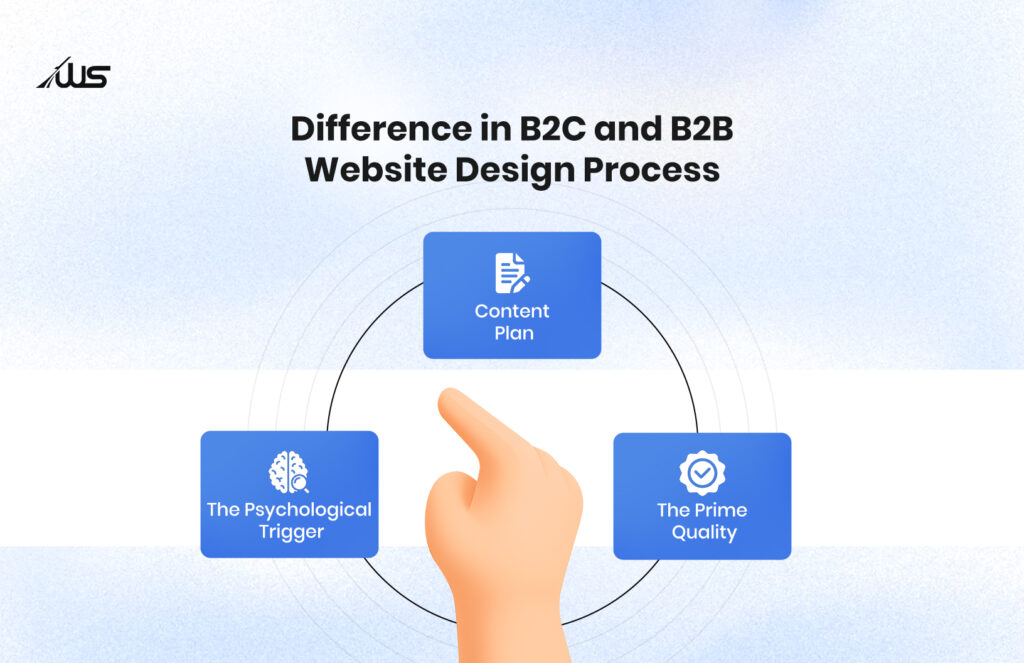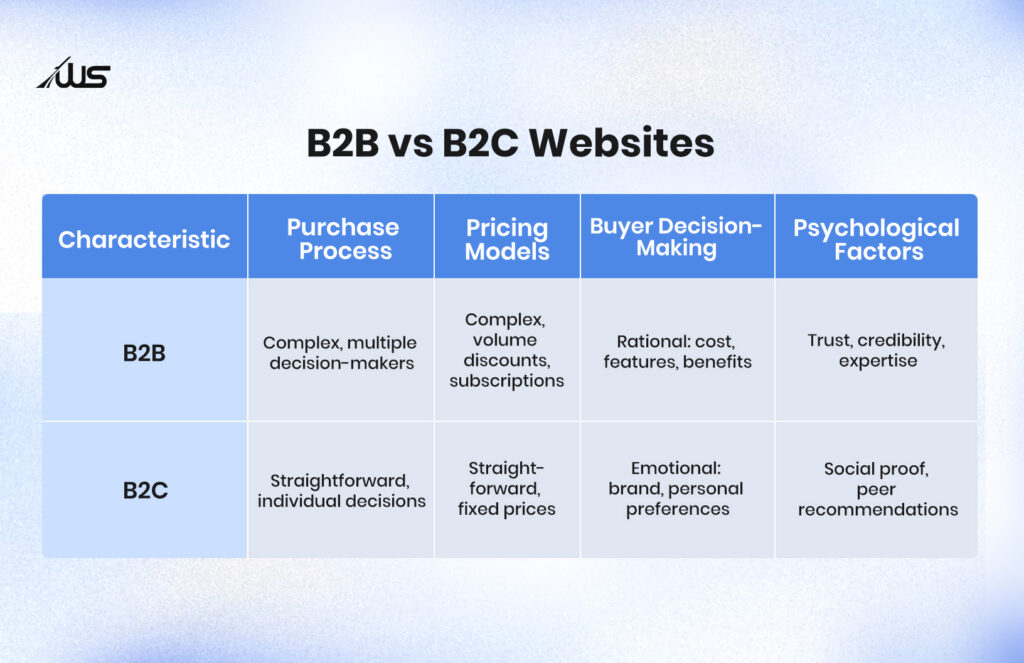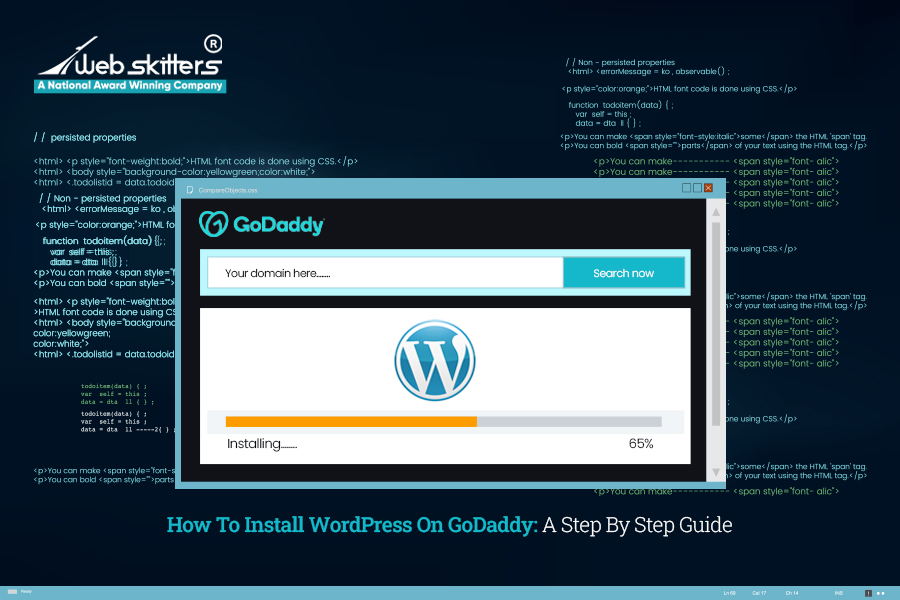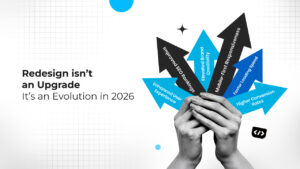The internet might tell you there’s no secret recipe for crafting the perfect B2B website design. However, we, a professional website design agency, have a contrasting opinion.
You don’t have to invest much money or time to develop the perfect. You must focus on the user’s needs and curate a discreet design for better engagement and appeal.
A quality B2B website design prioritizes users and delivers a fast-loading, comprehensive, and credible presence design for engagement and conversion.
On average, B2B websites see a bounce rate of about 20-45%. This means a sizable chunk of visitors leave directly from the homepage without exploring further.
If you are struggling to find the perfect solution for crafting a unique B2B website design, this is the perfect blog post.
This comprehensive read explores the intricacies of curating a B2B website design. We have discussed proven tactics for delivering a professional design structure and collaborating with a B2B website design agency.
Let’s begin.
What is B2B Website Design?
Let’s get down to the fundamentals first –
A B2B or business-to-business website is ideal for brands that serve other businesses with their products or services. The most distinct feature of a web presence is that it doesn’t target individual consumers or government entities.
As a business, you must understand that a B2B website design strategy is unique and apart from generic website design strategies. The primary reason is the decision-making journey – it is lengthy and involves more than the average number of people.
77% of businesses have concluded that numerous steps are considered when finalizing a B2B service and product. It is a complex process that involves multiple stakeholders. Therefore, the B2B branding strategy has its unique effectiveness in driving conversions.
However, if you are new to the B2B domain, it is vital to understand the difference between B2C and B2B website development and design approaches.
B2C and B2B Website Design
As you already know, the basic difference between B2C and B2B is the end consumer. B2C businesses serve customers directly, whereas B2B deals with other businesses and organizations.

Here are the fundamental differences in the website design process –
-
The Psychological Trigger
Emotional responses trigger B2C purchases. The primary goal of the website design is fostering convenience and relevancy. However, the emotional purchase in B2B is different. The decision to purchase has numerous layers, as there’s a reputation and team to handle.
-
Content Plan
B2C website design demands a standard in content – it must be compelling and attractive to keep users engaged and interested in investing.
The content of the B2B website design is a little different. Other businesses demand thorough information and deliver a credible presence throughout. It must inform the other company.
-
The Prime Quality
The prime focus of a B2C website design is usability. The user experience offers thorough content, smooth navigation, and comprehensive product supply. The overall design aspect is user-focused with the objective of better engagement.
A B2B business presence is unique in its stance, and the designing tactics differ from B2C plans. Therefore, it is vital to understand who you are catering to before creating a final website design.
Critical Tactics for Building a Winning B2B Website Design
Now that we’ve clearly understood the difference between B2C and B2B website design, let’s focus on understanding the various techniques of a successful B2B design –

1. Optimizing for Value Proposition
The most crucial element of a B2B website design is the unique value proposition that convinces another business to purchase or engage.
The B2B Gartner Report suggests that 99% of businesses make a B2B purchase for organizational upscaling purposes. Most businesses see better process solutions. However, B2B purchase decisions take time and involve multiple layers.
The great news is, as a B2B business owner, you have the tools to convince, and the ideal one is the value proposition.
Here’s how value proposition optimization is ideally done –
- With Content – Placement is crucial, and using content to deliver information helps, in this case, the value proposition. Effectively inform the target audience about their pain points and how your offering is designed to resolve it all.
- With Testimonials – Social proof is mandatory, whether through social content or reviews. While the value proposition can be convincing, it must have a credible touch. Testimonials ensure that you have an audience base that you have served and can showcase the positive results.
- With Layout: Content and testimonials are only visible when the layout is perfect. For instance, top-notch content can get overlooked in a cluttered presence. Ensure a simple B2B website design with clear instructions, proper content placement, and a distraction-free interface.
There is no right or wrong way to deliver a value proposition. As a business seeking a winning B2B website design, A/B tests are valuable and lead to quicker outcomes.
2. Analyzing Competitors’ Websites
The B2B market is cutthroat, and marketing ought to be premium. Therefore, understanding your competition is paramount.
One of the most effective ways to comprehend the competition is to analyze their websites. This
provides invaluable insights into industry trends, best practices, and potential areas for improvement.
Why is Competitor Analysis Crucial?
Analysis helps pinpoint web design strengths and weaknesses through competitor website studies. It offers a sense of current trends and emerging technologies can help you stay ahead of the curve, and provide innovative solutions to your target audience.
Comparing your website to competitors allows you to benchmark your performance and identify further possibilities. It helps optimize existing website design for better user experience and lead generation.
Popular Tools in the Arsenal that Help –
Several powerful tools can assist you in your competitor analysis:
- SEMrush: It is a comprehensive tool that provides insights into organic and paid search traffic, keyword rankings, backlink profiles, and competitor analysis.
- Ahrefs: It offers features similar to SEMrush, focusing on backlink analysis and competitive research.
- SpyFu: SpyFu is a valuable tool for analyzing your competitors’ PPC campaigns, including keywords, ad copy, and landing pages.
When analyzing competitors’ websites, pay attention to the following key elements –
- Evaluate the website’s navigation, layout, and overall usability. Does it provide a seamless and intuitive user experience?
- Examine the website’s structure and design. Is it visually appealing and easy to follow?
- Assess the quality, relevance, and organization of the content. Does it effectively communicate the company’s value proposition?
- Analyze the website’s on-page and off-page SEO tactics. Are they using relevant keywords, optimizing Meta tags, and building high-quality backlinks?
- Evaluate the effectiveness of the CTAs. Are they clear, compelling, and strategically placed?
Conducting a thorough competitor analysis offers valuable insights into the industry and helps identify opportunities to improve your B2B website design.
Remember, the goal is not to copy the competitors’ web design strategy but to learn from their successes and avoid mistakes.
3. Design an Intuitive B2B Homepage
The homepage is a digital storefront for a B2B business. It is visitors’ first impression of your brand and plays a crucial role in capturing their attention and driving action.
A well-designed homepage significantly impacts the website’s success and overall business performance.
You may not realize this, but 90% of B2B buyers research 2–7 websites before making a purchase decision. So, your site is constantly being compared to your competitors.
First Impressions Matter!
Let’s agree upon this universal truth: A visually appealing and informative homepage leaves a lasting impression on visitors. It must convey the company’s value proposition and entice users to explore further. A poorly designed homepage, on the other hand, can deter visitors and drive them away.
Here’s what to focus on and the critical elements of a successful B2B homepage –
- Clear and Concise Content: Your homepage must communicate the company’s mission, values, and unique selling points. Use concise language and avoid jargon to make the content easy to understand.
- Intuitive Navigation: A well-organized navigation menu makes it easy for visitors to find essential information. Use top-level website navigation for B2B with clear labels and subcategory drop-down menus.
- Prominent CTAs: Place clear and compelling calls to action (CTAs) throughout the homepage. It may include buttons, links, or forms encouraging visitors to take the desired action, similar to a conversion.
- Effective Use of Videos: Videos are a powerful tool for engaging visitors and conveying messages quickly and effectively. Consider using a video to showcase products or services, share customer testimonials, or explain the company’s unique value proposition.
- Optimizing CTA Placement: CTA placement significantly impacts design effectiveness. For instance, the ideal tactic is placing the most valuable CTAs above the fold and in the high-traffic areas for the most clicks. Additionally, the CTAs must align with the branding and deliver a cohesive presence.
These guidelines help create a homepage that effectively captures visitors’ attention. It conveys the brand’s message perfectly and drives them to take the desired actions.
4. Optimizing Website Layout for Easy Navigation
A well-organized and visually appealing website layout is essential for providing a positive user experience. It helps visitors navigate the design effortlessly and locate the necessary.
The layout itself impacts the visual appeal and usability. A cluttered or confusing layout deters visitors and makes it daunting to identify content.
Conversely, a clean and intuitive layout enhances the overall user experience and improves the website’s conversion rate.
Importance of Customization over Templates
While templates are a convenient and quick way to create a generic website, they lack the flexibility and customization options needed to stand out. Opting for a custom layout helps tailor the B2B website design to your specific brand and target audience.
Here are Tips for Effective Layout Optimization –
- Short and Descriptive Headers: Use clear and concise headers to guide visitors through the website and help them understand the content.
- Highlight Your Unique Selling Points (USPs): USPs must be prominently displayed on the homepage and throughout the website. It helps visitors quickly understand what sets your business apart.
- Showcase Significant Projects: If applicable, feature the most impressive projects or case studies on the homepage or a dedicated project page. It helps build credibility and attract potential clients.
- Ensure Mobile Responsiveness: With an increasing number of mobile users, the website needs to be optimized for smaller screens. A responsive B2B website design ensures the web design looks and functions well on all devices.
The B2B website design layout must be visually appealing and easy to navigate, improving user experience and driving conversions.
5. Add Clear Calls-to-Action (CTAs)
Calls to action (CTAs) are vital elements of any successful website design, be it B2C or B2B. They guide visitors toward the desired actions, like contacting sales, requesting a demo, or downloading a resource. Without clear and compelling CTAs, your website may fail to convert visitors into leads or customers.
Furthermore, effectively positioned CTAs help generate leads, increase sales, and build customer relationships.
To create effective CTAs, use action-oriented language, encouraging visitors to take immediate action. Here are some examples –
- “Request a Demo”
- “Contact Us”
- “Download Our Whitepaper”
- “Sign Up for Our Newsletter”
- “Start Your Free Trial”
Avoid using vague or generic language that doesn’t convey the desired action.
Strategic Placement of CTAs
The CTA placement on the B2B website design is as vital as any other layout aspect. Place CTAs in prominent locations where visitors engage or click.
Here are some key pages where CTAs are particularly effective –
- Homepage: Your homepage is the first page visitors see, so it’s a great place to include a prominent CTA that encourages them to explore further.
- Product or Service Pages: Include CTAs that relate directly to the product or service being described, such as “Buy Now” or “Learn More.”
- Landing Pages: Landing pages are designed to capture leads, so it’s essential to include a clear and compelling CTA that encourages visitors to fill out a form or sign up for a newsletter.
- Blog Posts: At the end of blog posts, include a CTA encouraging visitors to subscribe to your blog or download a related resource.
Strategically placing CTAs throughout the website and using clear and compelling language can effectively guide visitors to conversion, elevating the business.
6. Avoid Talking Too Much About Your Business
One common mistake most B2B brands make is focusing on promoting themselves and their products or services. While it’s crucial to highlight the company’s unique value proposition, it’s equally critical to focus on delivering a user-focused website design.
A User-Centric Approach
A user-centric approach involves putting the visitors’ needs first and tailoring the content and messaging to address their specific concerns and pain points. Your business must diligently inform the dealing businesses what you deliver, how it helps them, and why they should do business with you.
Focusing on providing value to the audience can build trust, establish credibility, and ultimately drive conversions.
For instance –
Consider that your business offers digital organizers for other companies to streamline the daily business process, similar to brands like Evernote, Calendly, and Trello.
The prime benefit is that you help businesses stay focused and organized. However, you can deliver more than that. Beyond promoting the organizer tool, highlight that the product can help them organize their lives, increase productivity, and achieve goals.
Using a similar approach, you can create an informative, engaging, and relevant website for the target audience. Remember, the goal is to show visitors how your business can solve their problems and improve their lives, not just sell them products or services.
7. Utilize Content Marketing
Content marketing has always been a powerful strategy for attracting and engaging visitors to a B2B website. Creating and sharing valuable content helps establish a business as an industry authority, generate leads, and build trust with the target audience.
Why High-Quality Content is Crucial?
High-quality content plays a crucial role in attracting and retaining visitors to the website. It helps to –
- Generate Leads: Providing valuable information and resources to attract potential customers actively searching for solutions to their problems.
- Build Trust: Consistent and informative content to establish the business as a trusted source of information in the industry.
- Improve SEO: Optimizing the content for search engines helps rank higher in search results and increase website visibility.
Types of Content to Create
Now, while the focus is on content marketing strategies, content can be any form of information. Each type of content is unique and is created to engage the visitors. Some popular options include –
- Blog posts: Share insights, tips, and advice on topics relevant to the industry. Offer detailed information about the various products and services.
- Videos: Create videos to demonstrate the products or services, share customer testimonials, or provide educational content.
- Case studies: Showcase successful projects or customer stories to highlight the benefits of working with your business.
- Webinars: Host webinars to provide in-depth information on specific topics and generate leads. B2B sales are different from B2C sales, so explanations are mandatory to create an authentic impression.
Developing a Content Strategy for B2B Website Design
It’s vital to develop a content strategy that aligns with your business goals and target audience through content marketing.
Here are some tips for creating a successful content strategy –
- Define your target audience: Identify the specific individuals or businesses you want to reach with your content.
- Identify your goals: Determine what to achieve with your content, such as generating leads, increasing brand awareness, or driving sales.
- Choose your content formats: Decide which types of content are the most effective for reaching your target audience and achieving your goals.
- Create a content calendar: Develop a schedule for creating and publishing your content to ensure consistency.
- Measure your results: Track critical metrics such as website traffic, leads generated, and social media engagement to assess the effectiveness of your content marketing efforts.
Content still rules the digital domain in attracting and converting users. Therefore, for an elegant and functional B2B presence, it is advisable to seek help from professional markets or a web design agency.
8. Personalize Website Copy for Each Customer Segment
Personalizing the web design copy for different audience segments significantly boosts engagement and conversions. Tailoring the messages to specific customer needs and interests creates a relevant and compelling experience.
One effective way to personalize web design is to segment the audience based on factors such as demographics, interests, and behavior.
Once you’ve identified the target segments, you can create content that resonates with each group. For example, you might use different language and imagery when targeting technical professionals versus general consumers.
Another helpful personalization tool is chatbots. Chatbots guide users through personalized experiences by asking questions and recommending relevant content or products. It helps improve customer satisfaction and increase conversions.
9. Ensure Fast Website Load Times
Website speed is critical in providing a positive user experience and improving the website’s performance. Slow load times drive visitors away and negatively impact search engine rankings.
To ensure fast website load times, focus on the following tips –
- Simple Web Design: Keep the website’s design clean and uncluttered. Avoid using excessive elements or animations that slow down page loading. Remember, a B2B website design can be simple yet innovative and unique.
- Image Compression: Optimize the images for web use by compressing them without sacrificing quality. It significantly reduces page load times.
- Fewer Redirects: Minimize the number of redirects on the website. Each redirect adds additional loading time.
- Minimize Plugins: Only use essential plugins and avoid unnecessary ones that can slow down the website.
- Optimize for Mobile: With the increasing number of mobile users, ensuring the website loads quickly on all devices is essential.
These tips improve the website’s load times and provide a better user experience.
10. Optimize for Mobile Devices
Smartphone and tablet dependency is skyrocketing steadily as we speak. Therefore, optimizing the B2B website design for mobile devices is essential.
Mobile devices now account for 63% of all website traffic, surpassing desktop usage. Hence, it is crucial to prioritize mobile-friendly B2B website design.
The Importance of Mobile Optimization
Mobile-optimized websites offer a better user experience and significantly impact the business’s success. Here are some key reasons why mobile optimization is crucial –
- Improved User Experience: Mobile users expect websites to be easy to navigate and load quickly on their devices. A mobile-optimized website provides a seamless experience and encourages visitors to stay longer and engage.
- Increased Conversions: If the website is designed appropriately, visitors will convert on mobile devices. Mobile-optimized CTAs, forms, and layouts make it easier for users to take the desired action.
- Better SEO Rankings: Google and other search engines now prioritize mobile-friendly websites for ranking. By optimizing the mobile web design, you can improve the search engine rankings and increase visibility for better organic traffic.
Key Elements of Mobile Optimization
To create mobile-friendly B2B websites, focus on the following elements –
- Ensure the web design adapts to different screen sizes and orientations. It can display correctly on various devices, from smartphones to tablets.
- Make sure the content is easily read and navigated on smaller screens. Use clear headings, bullet points, and concise paragraphs for elevated readability.
- Design your CTAs to be easily clickable and visible on mobile devices. Use large buttons and clear labels.
- Optimize the website’s speed to ensure it loads quickly on mobile networks. Minimize image sizes, reduce the number of redirects, and leverage browser caching.
Optimizing the B2B website design for mobile devices provides a better user experience, improves conversions, and boosts your search engine rankings.
11. Incorporate Chatbots to Enhance Customer Interaction
Chatbots have become essential for businesses, prioritizing a convenient and efficient way to interact with customers. Implementing chatbots on the B2B website design improves customer satisfaction, provides faster responses, and offers personalized interactions.
Let’s take a look at the benefits of using Chatbot for your B2B storefront –
- Fast Responses: Chatbots provide instant responses to customer inquiries, reducing wait times and improving overall satisfaction. The surge of AI innovations has elevated the Chatbot experience to the next level with personalized query redressal.
- Personalized Interactions: Chatbots are programmed to collect information about visitors and tailor their responses accordingly. While they can offer a personalized experience, the data collected is invaluable for scaling.
- Self-Service Options: Chatbots help customers find information without human assistance. They effortlessly help the team focus on more complex issues and business processes.
Curious about how AI is transforming chatbot interactions? Check out our in-depth post on AI Chatbots Going Out of Control to explore the latest trends and challenges shaping intelligent automation.
The Importance of Real-Time Customer Support
This fast-paced business environment calls for immediate action since the target audience’s attention span is barely around 4-8 seconds.
It’s crucial to provide real-time customer support. Chatbots help you achieve this by offering immediate assistance and addressing customer concerns promptly. Providing timely and helpful support helps build a stronger customer relationship and increase loyalty.
12. Include Customer Testimonials for Social Proof
Customer testimonials and reviews are a progressive tool for building trust and credibility with potential clients. Showcasing positive experiences from satisfied customers demonstrates the value of the products or services. It encourages others to do business with you.
The Importance of Social Proof
Social proof is a psychological phenomenon, and people are likely to follow the actions of others. When potential customers see that other businesses have had positive experiences with your company, they will trust your brand and consider doing business.
Here is how to capitalize on this psychological route –
To effectively use customer testimonials, highlight success stories, and demonstrate the benefits of your solutions. Share specific examples of how your products or services have helped other businesses achieve their goals.
You can include quotes from satisfied customers, case studies, or video testimonials. Showcasing real-world examples of your success helps build trust and credibility with your target audience.
If you are a beginner in the field, it can be daunting to deliver positive reviews. Learn interaction with customers to ensure the products and services you offer. A friendly connection leads to a better audience base and fosters togetherness.
13. Understanding Differences between B2B and B2C Website Designs
B2B and B2C websites have distinct characteristics due to the differences in their target audiences and buying processes. If you are launching into B2B, understanding these differences is crucial for creating effective website designs.

Key Differences –
- Purchase Process: In B2B, purchases often involve multiple decision-makers and a more complex evaluation process. B2C purchases are typically made by individuals and involve a more straightforward decision-making process.
- Pricing Models: B2B pricing models are more complex, involving volume discounts, negotiated pricing, and subscription-based models. B2C pricing is generally more straightforward, with fixed prices and limited discounts.
- Buyer Decision-Making: B2B buyers will likely base their decisions on rational factors like cost, features, and benefits. Emotional factors like brand reputation and personal preferences influence B2C buyers.
- Psychological Factors: B2B buyers prioritize trust, credibility, and expertise. B2C buyers are influenced by social proof and peer recommendations.
Each contributes to the B2B website design process and must align with the sales cycle. As a B2B brand, you must build relationships with multiple stakeholders through the storefront. The presence must provide ample information and resources to educate potential buyers and nurture them through sales.
14. Embrace Clean Design and Best Practices in B2B Website Design
The present market is all about unique and unconventional design structures meant to create a feeling of awe and thus lead to conversion.
However, the impact of a clean web design, especially for B2B user experience (UX), cannot be overstated. A clean design with a distortion-free navigation structure and a defined content plan has a lasting impression in the B2B domain. It contributes to a clear head in purchase decisions and delivers a credible factor among the target audience.
Here are some B2B website design best practices to consider –
- Understand the purpose of each web page – is it meant for appeal or information? Structure the pages likewise. When you deliver your users with the ideal outcome, it leads to trust and secure conversions.
- Focus on Clean structures – Avoid extreme clutter or content in the website design. Focus on a simple presence that is easy to navigate, and information is immediately available.
- Make it easier for the audience to contact you – Pay attention to the contact pages and offer relevant information. Since communication is mandatory for B2B sales, it ought to be simplified.
- Deliver professional – In B2B, you are dealing with simple users purchasing a product. Here, the audience is C-suite and is not looking for a cursory glance at things. The information, the design, and the overall presence must speak professionalism.
Consult with a B2B website design agency that has delivered to C-suite audiences and understands its philosophy. It is easier to explain your expectations to a skilled professional, and they know how to provide optimum results.
15. B2B Website Design is a Long-Term Commitment
Website design is not a done-and-dusted aspect of a website. It can be altered, however, and whenever, depending on the business objective and performance results. A long-term commitment means being willing to change and rework web design for better delivery.
Yes, similar to marketing and sales, a B2B website design has performance results, and it is trackable.
Here is how to measure B2B website design success –
- Have a Goal – It doesn’t matter if you are new to the B2B domain; you must have a target you are willing to achieve in a given time. The design structure must abide by the timeline, making comprehending the design outcome easy.
- Study the metrics—Similar to marketing and SEO, web design has metrics like engagement rate, conversions, time spent on a web page, and similar. These metrics offer a definite view of the user journey—the pages they are engaging with, the ones they are avoiding, content that did well, and things they are not resonating with. The overall metric offers a clear picture of which B2B website design element is offering the functionality needed.
- Interact—This is absolutely—directly interacting with the target audience and asking what works and what doesn’t. Interaction is a traditional and core method of business growth and scalability.
Be open to changes and testing wherever you deem fit. There is a stringent method of delivering the perfect B2B website design. Seek help from a professional B2B website design company to clearly understand what successful businesses are doing differently.
A Winning B2B Website Design with a Professional Website Design Agency
As a professional B2B website design agency, we adhere to these 15 principles to ensure a professional finish. The tactics are curated for better conversion and brand scalability, leading to better growth for both parties.
There is no definitive description of a winning B2B website design. It all comes down to how you define success. To some, it is more leads, and to others, more engagement.
However, one website design measure that has never failed to succeed is a user-focused one – delivering what the users expect from a business.
At Webskitters Technology Solutions Pvt. Ltd., we have a proven track record in B2B website design. Our professional team focuses on delivering a usable presence personalized to meet unique user bases. Kindly explore our plethora of B2B solutions and consult for your desired services.
Whether B2B design or development, the professionals at Webskitters have your back!
FAQs
1. What’s the main thing I should focus on when designing a B2B website?
We would suggest starting with clarity. Make sure anyone visiting your site can instantly tell what you do, who you serve, and how they can reach you, without having to scroll or guess.
2. How can I make my homepage perform better?
You can begin by tightening your headline and cutting extra visuals that don’t add value. Keep only what helps visitors move forward, like a short intro, trust badges, and of course, a clear call-to-action above the fold.
3. Is it really worth hiring a B2B website design agency?
If you want measurable leads, right? Then it would be a good idea to work with a team that understands conversion behaviour in your industry. An agency can run user tests, set up analytics. They would also structure the content in a way that shortens the buyer’s decision time.
4. Why do visitors leave my website so quickly?
This is most likely due to low website load speed or it could be because of your site is cluttered and confusing. Professional web designers use tools like Google PageSpeed Insights or GTmetrix to check how fast your pages load, then remove pop-ups or heavy graphics that slow things down.
5. How often should I update my website design?
It is recommended to perform a small design refresh every year and a full redesign every three to four years. That’s enough time for new technologies and design standards to shift. Plus it keeps your site relevant and trustworthy.


 December 29, 2024
December 29, 2024 









